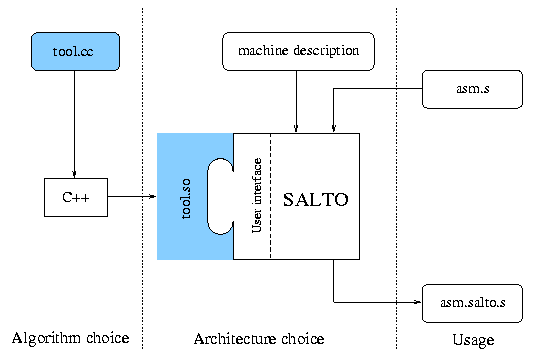Overview of Salto
Contents
For a more accurate description, you can refer to the documentation:
SALTO.PS or SALTO.PDF.
Online documentation is also available.
Introduction
A Salto application is composed of three parts: a kernel, a machine description file and
an optimization or instrumentation algorithm. Figure 1 illustrates the organization of these three components.
- The kernel performs common house-keeping tasks that the user doesn't
want to worry about. The parsing of the assembly-code and of the machine
-description file are done automatically, as are the construction of
the internal representation. This internal representation is available
via the user interface.
- The machine description file contains the hardware configuration and the
complete description of the instruction-set with reservation-tables.
- The optimization or instrumentation algorithm is supplied by the user.
Once the system has read the machine-description file and the assembly-
code, an internal representation is built and control is given to the
user through the call to a predefined function.

Figure 1: Overview of Salto
The data structures used in Salto are divided into two groups, depending on
their role. The first group represents the control flow of the program, the
second group describes resource usage and data dependencies between
instructions.
A program written in assembly-language can be viewed as consisting of several
procedures, each of which is a list of instructions. Within a procedure,
instructions are grouped into basic-blocks.
While parsing the code, Salto builds the list of the procedures it
encounters. Each procedure has a list of basic-blocks, and each block
``knows'' its list of instructions. The internal representation is hidden by
the user interface.
Additionally, the control flow graph is built for each procedure. The vertices
are the basic-blocks and the edges denote the execution order of the
basic-blocks. Edges are labeled to indicate if they correspond to the taken or
not-taken branch.
The second part of the data structures provided by Salto gives information
about the resources needed by an instruction to complete execution. A resource
is usually a register, a functional unit or the memory, but it could be any
piece of hardware needed to describe the behavior of the machine. Each
instruction needs a resource during a number of cycles with a particular
access mode: three modes are available for a resource: read,
write or use.
Each instruction is described by a reservation-table, which indicates the list
of resources it needs and the mode and cycle a resource is accessed. This
information is used when determining the type of dependence between two
instructions: RAW (read after write), WAW (write after
write), WAR (write after read).
Salto is designed to be a retargetable tool. Thus, the target machine must
be described in a flexible way, permitting an accurate description while
retaining the ability to easily modify parameters. This is achieved with a
Lisp-like language based on the reservation-table formalism. The description
file is parsed by Salto and an internal representation is built using RTL
(Register Transfer Language). The machine description contains:
- the syntax of the assembly-language used, that is, how does a
comment start, how many registers are there, and what are their names;
- all the resources needed for the computation of data dependencies;
- the list of the instructions recognized by the assembler with the
applicable formats and the associated reservation-tables;
- semantical information to warn Salto about special features
implemented in the processor like bypass-mechanism or
delayed branch.
A simplified description of the Sparc v7
architecture can be seen as an example.
The object-oriented user interface provides a flexible way to deal with the
internal data structures. Features of Salto include:
- access to the code at three different levels : procedure, basic-block
or instruction;
- modification of the code: insertion, deletion;
- unparsing;
- access to the reservation-tables;
- computation of dependencies and delays between instructions caused by
pipeline stalls;
- addition of attributes: attributes are a flexible way to put any kind
of information on a particular basic-block or instruction.
The easiest way to understand how the user interface is used, is to have a
look at small examples of tools written with Salto.
Erven.